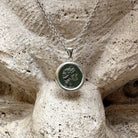GODDESS DEMETRA Genuine Ancient Roman Bronze Coin 225-200 BC Pendant
This pendant showcases an ancient bronze Roman coin with the image of Demeter, known as Ceres in Roman mythology. On the rear, we can find one of her classical attributes: two ears of wheat and a bird on a leaf.
Legend has it that Ceres bestowed upon the shepherd Aristaeus the knowledge to cultivate olive trees and extract oil from their fruits. Olive oil held immense significance in Roman culinary culture, finding its way into over three hundred recipes detailed in Marco Gavio Apicio's cookbook, De re coquinaria. From seasoning to frying, its versatile use permeated Roman gastronomy, enhancing dishes ranging from fish to pastries.
In Greek mythology, Demeter, daughter of Cronus and Rhea, reigns as the goddess of nature, agriculture, and the harvest cycle, responsible for the ebb and flow of seasons, life, and death. Roman mythology equates her with Ceres.
The tale of Demeter's daughter, Kore (Persephone), unfolds near Lake Pergusa, where Hades, with Zeus' consent, abducts her into the underworld while she gathers flowers. Demeter's relentless search for her lost daughter plunges the world into a prolonged winter, halting agricultural productivity until Kore's return is negotiated.
Complications arise as Kore, having consumed pomegranate seeds in the underworld, becomes tethered to its realm. Eventually, Zeus brokers a compromise: Kore will split her time between the underworld and the earth, with her stay below ground corresponding to the number of seeds consumed. Thus, each year, Demeter eagerly awaits Kore's return, heralding the rebirth of nature with the advent of spring.
The reconciliation between mother and daughter signifies a newfound understanding, as they embrace their altered roles and the equilibrium of their relationship evolves.
Our jewelry store, Serra Roma, proudly presents an exquisite collection that beautifully honors the ancient traditions of Greek and Roman civilizations. Each piece in our collection, including authentic ancient Roman and Greek coins and intaglios, is accompanied by a certificate of authenticity, providing proof of its historical significance and origin.


















